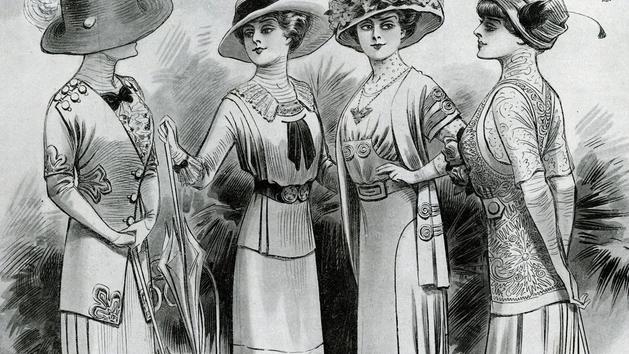In partnership with
RetroNews
, the BnF press site
Tool of emancipation or domination?
The skirt is back in the news with the assault of three young girls in Mulhouse and Strasbourg on the grounds that they were wearing this garment.
In 2020 again, women's clothing - short skirt, plunging neckline, crop top - is the object of all eyes, comments, injunctions and unfortunately violence.
Read also:
Women more inclined to ban the crop top and other
"non-republican outfits"
than men
The skirt, however, long a vector of male domination according to historian Christine Bard, became in the 1960s a means of female emancipation.
According to fashions and the evolution of society, it locks up or frees the one who wears it.
In this long history of women's fashion, let's take a look at a piece of clothing that symbolizes this duality, the
“
hobbled skirt
”
which gave birth to the culottes at the start of the 20th century.
Birth of the "low speed" dress
At the beginning of 1910, fashion played with women and imposed on wardrobes a skirt tightened at the bottom by a wide band with an interior martingale called obstacle.
It is lined with a device which under the petticoat restricts walking and prevents tearing of the garment.
"Slow speed
dress
"
,
"turtle dress"
,
"trampling rode"
,
"ataxia dress"
.
The imagination of the French is racing to make fun of the
"shackled"
dress or skirt
.
Cartoonists seize it the better to ridicule it.
The paternity goes to the couturier Paul Poiret who had however freed the woman from the corset.
“I released their upper body, but I hamper their legs,”
laughs the stylist.
The hindered or hindered skirt is taken up by all the seamstresses and caused a scandal.
For several reasons.
It is first of all suggestive, allowing the shapes to be guessed.
The Italian bishops consider it
"immodest"
, and banish from the churches the elegant ones who are dressed in it.
Absolution would even be refused to
"shackled"
, reports the press.
In England, they are no longer admitted to court.
According to the newspapers of the time,
"it is forbidden to run in front of the king and the queen the dangers which a too pronounced reverence would entail in one of these very adjusted dresses."
Queen Mary would also consider it improper
Paris, capital of fashion, offers the spectacle of a gigantic "bag race"
The shackled dress is accused of all evils.
Narrow, it would ruin the fabric manufacturers of Roubaix.
"It only takes four meters [of fabric] for the dress which once required eight or ten! ..."
, laments
The Excelsior
on November 25, 1911, which calls on the
"gracious trotte-menu"
to save the textile industry.
Grace, most find none in this new trend that ties women up and makes them look ridiculous.
We make fun of these poor souls subjected to the dictates of fashion to the point of abandoning all dignity.
In
Le Figaro
, the lesson is scathing but the fault is thrown on the time which brought to the skies quite eccentric artists.
The writer and poet Miguel Zamacoïs has a lot of fun in the June 25, 1910 edition:
“
It is appropriate to devote a few lines to what is and will undoubtedly remain one of the most curious examples of the degree of aberration to which a reasonable society can arrive.
I mean the fashionable dress, tight at the bottom, thanks to which one half of Paris gives the other the unexpected spectacle of a gigantic bag race.
These few lines should not be written for contemporaries, for those like you and me who are helpless and bewildered witnesses of this fit of mental alienation, what am I saying, clothing!
Our responsibility towards posterity, and to let them know that we were neither the dupes nor the accomplices of this delirium attack of very thin skirts. […]
We would be very wrong to be indignant at the appearance of the hobble skirt. It is, after all, only one of the natural, almost obligatory links in the revolution of contemporary taste. An era must have the dress it deserves, and we may only deserve that dress. […] Because, when you think about it, in what way is a skirt that prevents walking that it should facilitate in its kind stranger than what we are shown every day in exhibitions?
"
A sack race, yes, but marked by obstacles.
The newspapers compete with anecdotes about the falls that punctuate the day with a
"shackle"
.
The running boards of vehicles are guilty of sprains or fractures, we can no longer count the sometimes fatal falls on the stairs, even gales are risky.
Women must make up their mind to be hoisted like bundles into automobiles.
And the slightest journey looks like an endurance race.
Doctors are even worried about this
"inexorable sheath"
which
"slows down the functions of the skin"
.
The elegant, brave women ignore these concerns:
"The shackled dress will still be all-powerful during the winter of 1910-1911,"
warns the fashion column of the newspaper L'Action
.
It is therefore best to bravely make up for it, and not to talk about it again.
It is understood that we will continue for many months to trot, knees together, at a speed of two kilometers per hour ... "
The new scandal culottes
In the United States, the Americans, much more pragmatic, demand the lowering of the steps.
Thus the president of a women's club:
"We are not going to abandon our fashion because the steps are too high,
" she said
.
Let them be lowered!
Women claim to dress as they want and demand that they give up the hobbled skirt, if they please wear it, is outrageous. "
But the newspaper
La Gazette
, which on March 20, 1912, reported this affair, would like to point out
"to the ladies of Boston that the shackled skirt is no longer worn in Paris"
.
Less than two years after its appearance, the ephemeral hobbled skirt is no longer.
It gave way to the panty skirt, a new object of scandal.
This new garment is the logical continuation of the hobbled dress.
The skirt tightened at the bottom splits in two and frees the legs of women.
This time, she comes from England, carried by the riders, proud Amazons concerned about comfort.
In Paris, Paul Poiret, again, is in the driver's seat.
It offers oriental styles puffing at the ankles.
From February 11, 1911, he confided in
L'Excelsior
:
“
We have joked a lot about this already: we said - it was easy, by the way - that the woman was finally going to wear the panties.
It's a nasty little vaudeville word.
But when we see, we will appreciate better than instead of "masculinizing" the woman, the much-contested costume only proposes to show her in all the harmony of her line and in all the freedom of her native flexibility
. "
Alas, the culotte skirt is not only considered ugly or offensive.
It stirs the hatred of some.
Young women who dare to take it to the Bois or to the races are booed and even attacked.
The novelist Marcelle Tinayre is outraged in the newspaper
Le Matin
on March 22, 1911:
“What struck me as much uglier than the ugliest fantasies in fashion was the attitude of the crowd to the unfortunate women who exhibited these novelties. At the races, on the boulevard, Place de l'Opéra, models, employees of great couturiers, dressed in culottes by the will of the bosses, were rudely booed and even jostled. In London, in Madrid, they were insulted. In Vienna, they passed from insults to assault. there are people who find it very funny. I find that appalling. There is nothing uglier than the culottes, if not the welcome we give it. […] In reality the crowd does not care about aesthetics and morals. She gladly seizes the opportunity offered to satisfy, without risk, a brutal instinct, sometimes even a sadistic instinct. Very courageous men start by cursing an unhappy woman who does not answer anything and who panics. They end up molesting her, tugging her, tearing her apart, and if we let them do that they would hit her, bravely. "
Very quickly the newspapers gave it as stillborn but it was brought up to date in the 1940s. It was then a functional item of clothing suitable for the bicycle trips of French women faced with the shortage of gasoline.
In the 60s, it will return to the mini-skirt and the pants to provoke the debate.










/cloudfront-eu-central-1.images.arcpublishing.com/prisa/S7ERVSCT4FUVX6R7TUVBDNTH5Y.jpg)



